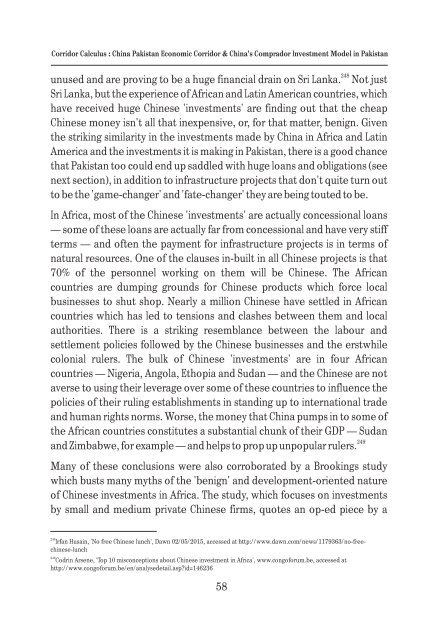Corridor Calculus
corridor-calculus-china-pakistan-economic-corridor-and-china-s-comprador-investment-model-in-pakistan
corridor-calculus-china-pakistan-economic-corridor-and-china-s-comprador-investment-model-in-pakistan
You also want an ePaper? Increase the reach of your titles
YUMPU automatically turns print PDFs into web optimized ePapers that Google loves.
<strong>Corridor</strong> <strong>Calculus</strong> : China Pakistan Economic <strong>Corridor</strong> & China's Comprador Investment Model in Pakistan<br />
248<br />
unused and are proving to be a huge financial drain on Sri Lanka. Not just<br />
Sri Lanka, but the experience of African and Latin American countries, which<br />
have received huge Chinese 'investments' are finding out that the cheap<br />
Chinese money isn't all that inexpensive, or, for that matter, benign. Given<br />
the striking similarity in the investments made by China in Africa and Latin<br />
America and the investments it is making in Pakistan, there is a good chance<br />
that Pakistan too could end up saddled with huge loans and obligations (see<br />
next section), in addition to infrastructure projects that don't quite turn out<br />
to be the 'game-changer' and 'fate-changer' they are being touted to be.<br />
In Africa, most of the Chinese 'investments' are actually concessional loans<br />
— some of these loans are actually far from concessional and have very stiff<br />
terms — and often the payment for infrastructure projects is in terms of<br />
natural resources. One of the clauses in-built in all Chinese projects is that<br />
70% of the personnel working on them will be Chinese. The African<br />
countries are dumping grounds for Chinese products which force local<br />
businesses to shut shop. Nearly a million Chinese have settled in African<br />
countries which has led to tensions and clashes between them and local<br />
authorities. There is a striking resemblance between the labour and<br />
settlement policies followed by the Chinese businesses and the erstwhile<br />
colonial rulers. The bulk of Chinese 'investments' are in four African<br />
countries — Nigeria, Angola, Ethopia and Sudan — and the Chinese are not<br />
averse to using their leverage over some of these countries to influence the<br />
policies of their ruling establishments in standing up to international trade<br />
and human rights norms. Worse, the money that China pumps in to some of<br />
the African countries constitutes a substantial chunk of their GDP — Sudan<br />
249<br />
and Zimbabwe, for example — and helps to prop up unpopular rulers.<br />
Many of these conclusions were also corroborated by a Brookings study<br />
which busts many myths of the 'benign' and development-oriented nature<br />
of Chinese investments in Africa. The study, which focuses on investments<br />
by small and medium private Chinese firms, quotes an op-ed piece by a<br />
248<br />
Irfan Husain, 'No free Chinese lunch', Dawn 02/05/2015, accessed at http://www.dawn.com/news/1179363/no-freechinese-lunch<br />
249<br />
Codrin Arsene, 'Top 10 misconceptions about Chinese investment in Africa', www.congoforum.be, accessed at<br />
http://www.congoforum.be/en/analysedetail.asp?id=146236<br />
58


